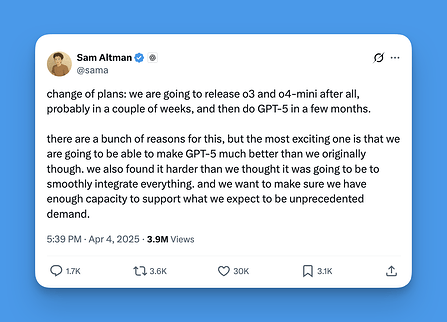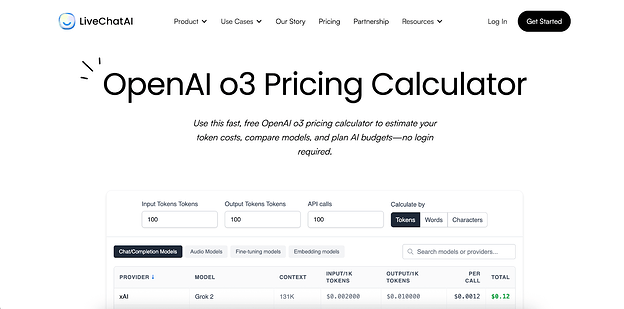Is GPT-5 really coming this year? 
Hey folks! I keep seeing Sam Altman hint that GPT-5 is almost here, but the timeline keeps moving. Can anyone lay out what’s officially confirmed so far and what we should realistically expect?
Bonus: How will it stack up against GPT-4o and the o-series reasoning models? I build Shopify apps, so I’m keen to know practical impacts.
OFFICIAL TIMELINE ROUND-UP
I stalk Altman’s feed and OpenAI newsroom the way some people follow football.
Key Dates & Statements
TL;DR: Expect public launch Q3 → early Q4 2025 unless something explodes. 
WHAT WILL GPT-5 DO DIFFERENTLY?
(nerd dive, buckle up)  )
)
1. Unified Reasoning Engine
-
Inherits fast intuition (GPT-4o) + chain-of-thought logic (o-series).
-
Model decides when to brainstorm, when to answer instantly – no dropdowns.
2. Multimodality v2
-
Native text + image + voice I/O in one chat – no “beta” tag.
-
Agentic tool-use: can search web, run Python, or generate images without user prompting.
-
Example: “Explain this graph and draft an email summary” → GPT-5 reads graph, cites source, writes email, attaches PNG.
3. Long-Term Memory & Personalization
-
ChatGPT remembers prior sessions (opt-in).
-
Uses memory to adapt tone, recall preferences, follow long projects.
-
Privacy controls: toggle, wipe, export.
4. Safer, Bigger Context
-
Rumored 256K+ token window for API; consumer tier likely smaller.
-
Runs through upgraded HealthBench, LawBench, FinanceBench before release.
Why it matters: Less babysitting. You issue one natural request; GPT-5 figures out the rest.
2 Likes
I run ops for a DTC brand, and I’ve been thinking a lot about how we’ll put GPT-5 to work from day one. Here’s the plan:
 BUSINESS & PRODUCTIVITY USE CASES I’M PLANNING
BUSINESS & PRODUCTIVITY USE CASES I’M PLANNING
 Automated Research Pods
Automated Research Pods
I plan to use Deep Research mode to scan competitor websites, customer reviews, and trend data—then have GPT-5 draft internal strategy briefs or pitch decks. It should handle the grunt work of pulling insights so we can move faster.
 Smarter Email & Support Tickets
Smarter Email & Support Tickets
We’ll start by letting support reps use GPT-5 to generate better canned responses on the free tier. If it proves reliable, we’ll upgrade to the Pro version and let it handle full ticket resolutions for common issues.
 Code Co-Pilot 2.0
Code Co-Pilot 2.0
I’m expecting big improvements on the dev side. With Codex-1 already showing promise, GPT-5 should make things like instant unit test generation and code refactoring suggestions much more accurate. We’ll likely test it on front-end bugs and theme tweaks first.
 Shopify App Docs, Done for You
Shopify App Docs, Done for You
One of the more exciting plans is to feed GPT-5 our Liquid templates and metafields, and have it auto-generate Shopify app documentation and onboarding tours. If it works, this could save our product and support teams a ton of time.
What I’m Doing Now to Prepare 
- Tagging internal docs by topic so GPT-5 can ingest them faster when we plug it in.
- Budgeting for the Pro subscription—especially if Deep Research is locked behind it. That feature looks like a game-changer.
I’m bringing this up after the snapshot because many people overlook pricing when the excitement starts. I’ve been running large-scale content workflows since GPT-3, so I want to share what I know.
1. Why Token Math Still Matters in a GPT-5 World
-
Unified model ≠ unified price. Altman confirmed tiered intelligence, which almost certainly means different $/1K-token rates for Free, Plus, and Pro levels.
-
Reasoning chains in GPT-5 can be longer (think multi-step CoT) → higher token outflow even if you send the same prompt.
-
Memory calls? Those prior chat snippets will get re-injected as context, and yes, they count against your usage.
2. Current Benchmarks (Official 2025 Numbers)
| Model |
Prompt Tokens |
Completion Tokens |
Blended Cost (est.) |
| GPT-4o |
$0.003 / 1K |
$0.006 / 1K |
~ $0.0045 |
| o3 Reasoning |
$0.005 / 1K |
$0.01 / 1K |
~ $0.0075 |
| GPT-4.5 |
TBD (early access) |
TBD |
Expect 15–20 % above 4o |
| GPT-5 (rumored) |
Altman says “similar to o-series,” so plan for ~$0.007–0.01 blended |
|
|
(All USD, pay-as-you-go; enterprise deals vary.)
I use LiveChatAI’s (LCAI) free pricing calculators because they add new models the week they ship. Example:
- They already list o3 Reasoning (literally dropped 14 days ago).
- You can toggle “chain-of-thought factor” which inflates tokens by 30 % to simulate deeper reasoning. Handy for GPT-5 budgeting.
How I use it
-
Enter inputs in whatever format you like—words, characters, or raw token counts.
-
Set average responses per call and API calls per month.
-
Hit Calculate → the tool converts everything to tokens, applies the right rate, and spits out monthly spend + break-even tips (e.g., “Switch to batch API for >50K calls”).
-
Export the table and hand it to finance—done.
 Run your current GPT-4o usage through the calculator, then add 20 % tokens and the o-series rate. That’s a conservative starting budget for GPT-5.
Run your current GPT-4o usage through the calculator, then add 20 % tokens and the o-series rate. That’s a conservative starting budget for GPT-5.
CODERS, READ THIS!
Spent a week with Codex-1 (o3). If GPT-5 is the fusion, expect:
-
End-to-End Feature Tickets
- Paste JIRA story → GPT-5 spits out React component, tests, and docstring.
-
Multi-File Refactors via agentic tool-use.
-
Better Context Awareness: 256K tokens ≈ entire small repo in one prompt.
Prep Tip:
Start writing clear commit messages & docs now; GPT-5’s suggestions improve when repo hygiene is decent.
There is one more topic I would like to mention.
If GPT-5 remembers everything, how can we control it? 
A series answer (according to OpenAI documents):
Memory is disabled by default for minors and new users.
The memory tab allows you to do the following:
 View stored fragments.
View stored fragments.
 Delete them individually or all at once.
Delete them individually or all at once.
 Pause memory capture.
Pause memory capture.
Data is stored encrypted; it is linked to the account, not the conversation ID.
Additionally, you can read this content, which contains quite detailed and valuable information:
1 Like
THREAD SUMMARY & TAKEAWAYS 
If you skimmed, read this!
1. Launch Window: Mid–late 2025. Delay was to bake in o-series reasoning → bigger leap.
2. Unified Model: No more “GPT-4o vs. o3 vs. 3.5” – GPT-5 adapts.
3. Capabilities:
-
Chain-of-thought reasoning on-demand.
-
Full multimodal (text/image/voice) + autonomous tool use.
-
Long-term, opt-in memory ⇒ personalization.
4. Access & Pricing:
5. Sector Impacts:
-
Productivity – auto-research, coding, CX tickets.
-
Education – adaptive tutoring, step-wise explanations.
-
Healthcare – assistive triage, paperwork, lit reviews (guard-railed).
6. Prep Checklist 
-
Clean your docs/repos; tag critical content.
-
Draft internal policy on memory/privacy.
-
Budget for Pro tier if you need complex research or agent workflows.
-
Pilot low-risk use cases first (e.g., marketing drafts) before mission-critical deployment.
Remember: GPT-5 isn’t magic; garbage in, garbage out. Feed it structured, accurate data and define clear guardrails. Then enjoy the  .
.



